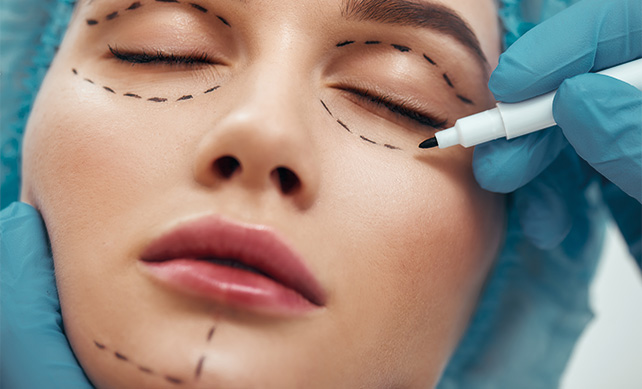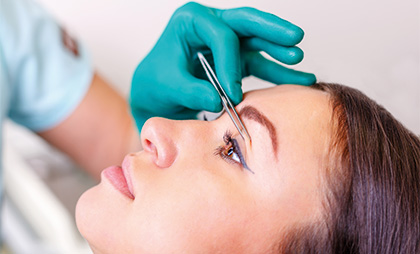What is a Blepharoplasty (Eyelid Left) Surgery
Due to various factors like aging and environmental influences, people’s facial features can undergo changes over time. One common cosmetic solution for this is blepharoplasty, or eyelid lift surgery.
With age, the muscles surrounding the eyes tend to weaken, leading to sagging upper and lower eyelids, as well as drooping eyebrows and the development of under-eye bags. Blepharoplasty addresses these concerns by tightening the eyelids, removing excess skin, natural creases, and accumulated fat from both the upper and lower eyelids. This procedure aims to reshape the eyelids to enhance the overall appearance of the eyes.
Typically lasting around two hours, the surgery involves treating both the upper and lower eyelids. In some instances, patients may opt to combine blepharoplasty with a brow lift to achieve a more comprehensive rejuvenation.
It also has low-risk side effects, such as swelling, but disappears within one or two weeks. The results of the upper lids last for 5-7 years, while it is rare for the person to undergo the lower eyelid surgery again because it lasts for a long time.



Candidates For Blepharoplasty
Candidates for blepharoplasty should be in good health and free from specific medical conditions that could pose risks during or after the procedure. Common conditions to consider include:
- Thyroid disorders, dry eyes, and hypertension.
- Circulatory issues and cardiovascular diseases.
- Diabetes.
- Retinal detachment and cataracts.
- Psychological stability and realistic expectations are essential for the patient.
- Candidates should generally be at least 35 years old.
Pre-Operative Instructions For Blepharoplasty
Before undergoing eyelid lift surgery, it is essential to adhere to certain recommendations:
- Complete all necessary medical tests as advised by your healthcare provider.
- Follow the prescribed medication regimen provided by your doctor, and inform them about any medications you are currently taking.
- Refrain from smoking for at least one month before the surgery. Additionally, avoid consuming aspirin, NSAIDs, or herbal supplements known to cause bleeding and swelling for at least two weeks prior to the procedure.
- Cease the consumption of stimulants such as caffeine and alcohol at least two weeks before the operation, as they may interfere with anesthesia. Avoid blood thinners like green tea to prevent excessive bleeding and promote a smoother recovery process.
Blepharoplasty Stages
At Benew Clinic, we specialize in Blepharoplasty (Eyelid Lift) surgery, which involves three straightforward stages:
- Anesthesia: Our priority is ensuring the patient’s comfort and pain-free experience during the procedure. Depending on individual needs, patients receive either general or local anesthesia, selected by our experienced plastic surgeons.
- Surgical Incision: Precision is key in planning incision lines to conceal any resulting scars within the eyelid’s natural contours. For upper eyelids, incisions are strategically placed to access and tighten muscles, remove or reposition excess fat, and eliminate sagging skin. Lower eyelid incisions are made beneath the lash line to address fat distribution.
- Incision Closure: Following the necessary adjustments, the surgeon meticulously closes the incisions using stitches. These stitches are typically removed after one week, allowing for optimal healing.
By adhering to these steps, we aim to deliver reliable results with a high success rate, ensuring our patients achieve their desired outcomes.



Post-Operative Instructions For Blepharoplasty
To ensure a smooth and speedy recovery post-surgery, it’s important to adhere to the following guidelines:
- Apply ice packs to the eyes for ten minutes every hour immediately after the procedure, using them four to five times daily thereafter.
- Thoroughly cleanse the eyelids with prescribed eye drops and ointments.
- Avoid stress and strenuous activities for the first week post-surgery, as they may impede healing.
- Refrain from swimming for at least one week following the operation.
- Abstain from vigorous exercises for at least a week after the procedure.
- Cease smoking for a minimum of one week to promote optimal healing.
- Resist the urge to rub or scratch your eyes to prevent any potential harm.
- Avoid using contact lenses for at least two weeks post-surgery.
- Wear sunglasses to shield your eyelids from sun exposure and wind.
- Elevate your head higher than your chest while lying down or sleeping for several days following the operation.
- Refrain from taking blood thinners, including aspirin, ibuprofen, and herbal supplements, for at least one week to reduce the risk of bleeding.



